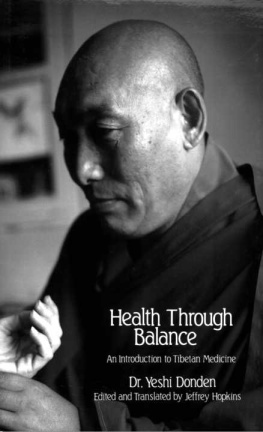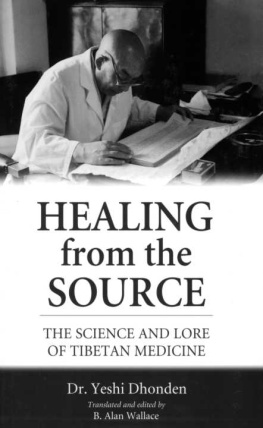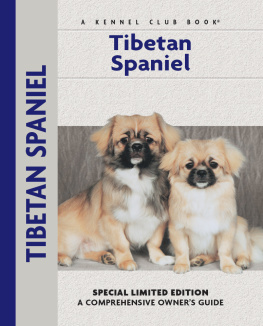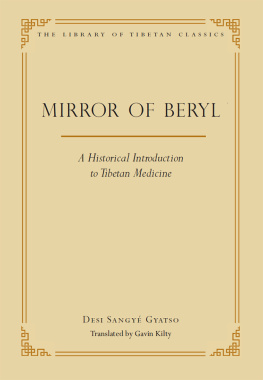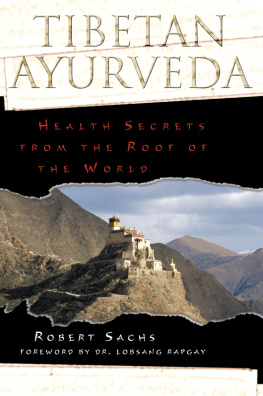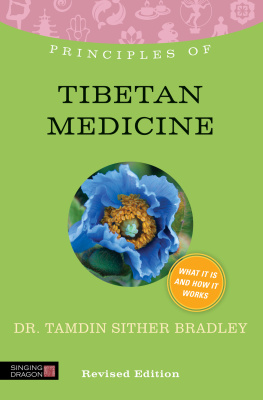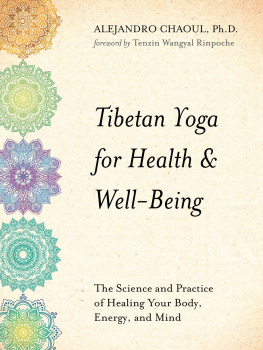Healing Elements
Healing Elements
Efficacy and the Social Ecologies
of Tibetan Medicine
Sienna R. Craig

University of California Press, one of the most distinguished university presses in the United States, enriches lives around the world by advancing scholarship in the humanities, social sciences, and natural sciences. Its activities are supported by the UC Press Foundation and by philanthropic contributions from individuals and institutions. For more information, visit www.ucpress.edu .
University of California Press
Berkeley and Los Angeles, California
University of California Press, Ltd.
London, England
2012 by The Regents of the University of California
Library of Congress Cataloging-in-Publication Data
Craig, Sienna R.
Healing elements : efficacy and the social ecologies
of Tibetan medicine / Sienna R. Craig.
p. ; cm.
Includes bibliographical references and index.
ISBN 978-0-520-27323-8 (cloth : alk. paper)
ISBN 978-0-520-27324-5 (pbk. : alk. paper)
I. Title.
1. Medicine, Tibetan TraditionalTibet. 2. Asian Continental Ancestry GroupethnologyTibet. 3. Holistic HealthTibet. WB 55.T5
610.51'5dc23
2012007775
Manufactured in the United States of America
21 20 19 18 17 16 15 14 13 12
10 9 8 7 6 5 4 3 2 1
In keeping with a commitment to support environmentally responsible and sustainable printing practices, UC Press has printed this book on Rolland Enviro100, a 100% post-consumer fiber paper that is FSC certified, deinked, processed chlorine-free, and manufactured with renewable biogas energy. It is acid-free and EcoLogo certified.
In memory of Yeshi Chdron Lama (19692006)

Thomas Kelly
Contents
Illustrations
Preface
This book is dedicated to Yeshi Chdron Lama (19692006), a friend and colleague who died tragically, along with twenty-three others, in a helicopter crash in eastern Nepal on September 26, 2006. The daughter of a Tibetan lama, Yeshi joined the World Wildlife FundNepal program in 1997 and began working on a project that aimed to document the ethnobotanical knowledge of amchi, Tibetan medical practitioners, in Dolpa District. What began for Yeshi as a project management assignment turned into a deep personal and professional commitment to amchi, to the environments they steward and on which they rely, to the cultural and scientific knowledge they hold, and to the communities they serve. She earned a bachelors degree from Middlebury College in Middlebury, Vermont, and an advanced degree in anthropology from the School of Oriental and African Studies in London, where her work focused on amchi experiences of and involvement with conservation and development in Nepal.
Wry, ironic, and smart, Yeshi was intimately aware of the profound differences between life in Kathmandu and life in the mountains. She saw clearly the challenges faced by the amchi with whom she worked. They were her friends and collaborators, not simply local informants. Her fluency in Tibetan and her comfort in the villages along Nepals northern edge served her well. Yeshi bridged many worlds with grace. She was marked by her years in Nepal and her educational experiences in the United States and the United Kingdom. She held fast to her familys history in Tibet even as she made her peace, as so many Tibetans do, with the lived experience of exile. She was a scholar, inquisitive and skeptical, with a deeply collaborative spirit and a commitment to the exchange of knowledge across divides of language and culture. She was also a practitioner, dedicated and filled with a sense of duty to the people with whom she worked. Friend, you are remembered, and missed.
Acknowledgments
Books often feel like singular endeavors, but they require a network of encouragement and critical feedback to produce. David Holmberg guided me with skill and kindness through the Ph.D. process and through many other scholarly and personal transitions. Davydd Greenwood and Vincanne Adams have been true exemplars. Mona Schrempf has been as gracious to me as she has been wise. Mark Unno and Harold Roth provided clarity and compassion at critical junctures, both in writing and in life. I owe a great deal to Tshampa Ngawang, not the least of which for his willingness to let me in, to be my teacher. I owe a similar debt of gratitude to Gyatso and Tenzin Bista and Mingkyi Tsomo (Mingji Cuomu).
I am fortunate to be part of a smart, collaboratively minded, and sincerely fun group of people engaging with Tibetan medicine across continents, languages, and disciplines. Ive benefited from dialogues, on and off the page, with Florian Besch, Calum Blaikie, Alessandro Boesi, Alejandro Chaoul, Carroll Dunham, Frances Garrett, Barbara Gerke, Suresh Ghimire, Denise Glover, Kim Gutschow, Susan Heydon, Theresia Hofer, Stephan Kloos, Alex McKay, Colin Millard, Laurent Pordi, Audrey Prost, Jan Salick, Geoffrey Samuel, Martin Saxer, Herbert Schwabl, Brion Sweeney, Yildiz Thomas, and Claudia Witt.
I have also benefited from the collegiality, friendship, and insightful scholarship of others in Tibetan and Himalayan studies: Ann Armbrecht, Cynthia Beall, Mary Cameron, Geoff Childs, Andrew Fischer, David Germano, Melvyn Goldstein, Janet Gyatso, Ian Harper, Amy Heller, Toni Huber, Leonard van der Kuijp, Todd Lewis, Kabir Mansingh-Heimsath, Charlene Makley, Kathryn March, Carole McGranahan, Stacy Leigh Pigg, Anne Rademacher, Charles Ramble, Tashi Rapgay, Franoise Robin, Volker Scheid, Sara Shneiderman, Nicolas Sihl, Mark Turin, and Emily Yeh. I owe particular thanks to those who participated in a May 2011 manuscript review hosted by the John Sloane Dickey Center for International Understanding at Dartmouth College, during which the scope, meaning, and form of this project came into clearer view: Rebecca Biron, Douglas Haynes, James Igoe, Craig Janes, Kirin Narayan, Theodore Levin, John Watanabe, and Christiane Wohlforth.
Other colleagues, friends, and practitioners of Tibetan medicine who live and work in Nepal and Tibetan areas of China have contributed in innumerable ways to this book. In Nepal, I am particularly grateful to Amchi Nyima and his teacher, the late Amchi Gege, as well as Menla Phuntsok, Amchi Wangchuk, Lama Namgyal, Tenzin Darkye, and the late Lama Drukgye. I also thank Jigme S. P. Bista, Tsewang Bista, Raju Bista, Nirmal and Laxmi Gauchan, Kunzom Thakuri, Chimi Dolkar Bista and Tshampa Angyal, Dawa and Mahendra Bista, and Angya and Palsang Gurung.
In Qinghai Province, China, I thank colleagues at Arura, specifically Dhondrup Drotsang, Renchen Dhondup, Kunchok Gyaltsen, O Tsokchen, Lusham Gyal, and Dorje. In Yunnan, I thank Samdrup Tsering and Ma Jiangzhong (Tibi Tsering). In the TAR, I thank members of the NIH and OneHeart teams as well as other Tibetan colleagues who remain unnamed but who have worked tirelessly to practice, document, and teach Tibetan medicine and provide compassionate, high-quality health care in Tibetan areas of China during uncertain times. Although India has not been a central focus of my fieldwork, Dr. Dawa, former director of the Dharamsala Men-tsee-Khang, and expert in materia medica, has always been generous with his time and as humble as he is learned.
Others have taught me much about medicine, global health work, and Tibet. I acknowledge Sibylle Christensen, Tim Dye, Bernhard Fassl, Suellen Miller, Michael Varner, and especially Arlene Samen. Enrico DellAngelo, Elena McKinley, Ursula Rechbach, Gerald Roche, Kevin Stewart, Paula Vanzo, Phuntsok Wangmo, and Yangga have offered sound advice and invaluable perspectives over the years.
Next page

